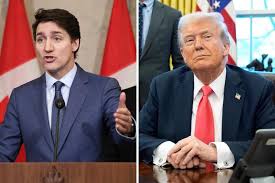Just when global markets thought things might be settling, another trade spat is boiling over—this time between the U.S. and one of its closest allies, Canada.
After former President Donald Trump abruptly ended trade talks with Canada, the Canadian government hit back swiftly, slapping new surcharges on American steel.
Canada Responds with Steel Tariff Punch
Late Friday night, Canada announced it was putting an import quota on American steel.
Anything beyond that quota? It’ll be taxed with a hefty 50 percent surcharge.
The move is Canada’s answer to what it sees as “unjust” tariffs from the U.S., according to Finance Minister François-Philippe Champagne.
It didn’t help that, earlier the same day, Trump took to Truth Social to blast Canada as “very difficult to trade with.”
His issue? A new tax Canada plans to impose on major tech firms—most of them American.
Why Trump Pulled the Plug on Trade Talks
So what sparked this sudden fallout? Canada’s digital services tax, which kicks in Monday.
The three percent levy targets tech giants like Google, Amazon, Meta, Uber, and Airbnb—any company earning more than $15 million from Canadian users.
And it’s not just a future charge. The tax is retroactive to 2022, meaning U.S. firms could be on the hook for as much as $3 billion in back payments.
Trump didn’t mince words: “We are hereby terminating ALL discussions on Trade with Canada, effective immediately,” he posted online.
U.S. Steel Gets Dragged Into the Crossfire
Caught in the middle of this diplomatic tit-for-tat is the U.S. steel industry—already in shaky shape.
Just this month, U.S. Steel merged with Japan’s Nippon Steel after years of flagging performance.
Now, with Canada’s 50 percent surcharge hanging over American steel exports, things could get even bumpier.
For context, Canada remains the second-largest trading partner of the United States.
And it’s one of the biggest foreign buyers of American steel and aluminum—industries that have already suffered heavy losses under Trump-era tariffs.
A History of Tariff Tensions
These latest moves are just part of a bigger picture.
Since early April, the U.S. has been imposing a 25 percent tariff on Canadian goods not covered under the USMCA (the trade deal Trump inked during his first term).
Even Canadian energy products, which are technically exempt from that 25 percent, still get hit with a 10 percent duty.
On top of that, Trump’s tariffs on foreign-made vehicles and parts have taken a toll on Canadian manufacturers.
Since the first wave of U.S. tariffs in March, Canada’s steel sector has laid off around 1,000 workers.
Canada Hints at More Retaliation
Canada isn’t backing down. Officials say they’re open to taking “additional steps” if Trump escalates things further.
For now, they’re watching closely as the U.S. barrels toward another major deadline—July 9.
That’s when Trump plans to start enforcing what he calls “reciprocal tariffs”—meaning countries that don’t lower their own trade barriers will face stiff penalties from the U.S. Some tariffs could hit 50 percent.
Is There Room for Compromise?
Despite the sharp rhetoric, not everything is set in stone. U.S. Treasury Secretary Scott Bessent hinted on Friday that the 90-day pause on reciprocal tariffs, first introduced in April, could be extended until Labor Day.
And hours later, Trump suggested the July 9 deadline was flexible.
“It could be shortened or extended,” he said—leaving the door open for last-minute deals.
Markets Watch Nervously as Allies Clash
All eyes are now on how this trade fight will ripple through global markets.
With Trump’s tough talk and Canada’s immediate retaliation, there’s concern that more countries might start choosing sides—or start planning their own pushback.
In the meantime, businesses on both sides of the border are left holding their breath.

